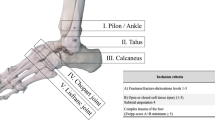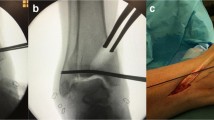Abstract
The purpose of this study is to compare the long-term clinical outcomes of patients who were treated with either hind foot reconstruction or amputation in complex hind foot injuries accompanied with bone and soft tissue loss due to land-mine explosions. Between 1994 and 2004, all patients with hind foot complex injuries due to land-mine explosion, who were operated in our clinic, were enrolled to the study. All patients were evaluated with Short-Form 36 (SF-36), Foot and Ankle Disability Index (FADI) and Body Image Quality of Life Inventory (BIQLI) after a mean of 15.1 ± 2.2 (range 9–19) years of follow-up. Demographic characteristics, number of operations, necessity of psychiatric treatment and all complications were compared between groups. There were a total of 42 patients [21 in reconstruction group (Gr I) and 21 in amputation group (Gr II)]. The mean age at the time of final follow-up was 38.4 ± 3.04 years in Gr I and 38.2 ± 4.24 years in Gr II (p = 0.732). The mean follow-up duration was 15.7 ± 2.07 years in Gr I and 14.57 ± 2.29 years in Gr II (p = 0.081). The number of operations was significantly higher in Gr I (8.66 ± 10.2 times vs. 4.42 ± 7.7 times, respectively, p = 0.001). The mean FADI score at the final follow-up was 64.3 ± 18.1 in Gr I. In amputation group, more patients needed psychotherapy due to major depression (12 patients vs. 4 patients, p = 0.012). Major complications in Gr I were musculocutaneous flap atrophy in calcaneal region (n = 8 patients), limited ankle motion (n = 11) and painful osteophytes on plantar region (n = 6). In Gr II, stump problems were dominating (pain and tenderness n = 10, ulcer n = 2, allergic skin lesions n = 7, painful neuroma n = 10, bony spur n = 5, paresthesia n = 1, excessive sweating n = 12). At the final visit, although SF-36 scores were similar between groups (p = 0.182), extremity reconstruction group had significantly higher BIQLI scores than the amputation group (p = 0.016). If the dorsalis pedis is intact and midfoot and forefoot is relatively protected, hind foot reconstruction should be attempted. Long-term outcomes of hind foot reconstruction are satisfactory with minor complications and better BIQLI.



Similar content being viewed by others
References
Gür E, Ateşalp S, Başbozkurt M, Aydoğan N, Erler K (1999) Treatment of complex calcaneal fractures with bony defects from land mine blast injuries with a circular external fixator. Foot Ankle Int 20(1):37–41
Oztürk S, Bayram Y, Möhür H, Deveci M, Sengezer M (2005) Evaluation of late functional results of patients treated with free muscle flaps for heel defects caused by land-mine explosions. Plast Reconstr Surg 116(7):1926–1936
Tintle SM, Keeling JJ, Shawen SB (2010) Combat foot and ankle trauma. J Surg Orthop Adv 19(1):70–76
Ebrahimzadeh MH, Rajabi MT (2007) Long-term outcomes of patients undergoing war-related amputations of the foot and ankle. J Foot Ankle Surg 46(6):429–433
Hoogendoorn JM, van der Werken C (2001) Grade III open tibial fractures: functional outcome and quality of life in amputees versus patients with successful reconstruction. Injury 32(4):329–334
Oestern HJ, Tscherne H (1983) Pathophysiology and classification of soft tissue damage in fractures. Orthopade 12(1):2–8
Ilizarov GA, Frankel VH (1988) The Ilizarov External Fixator, a physiologic method of orthopaedic reconstruction and skeletal correction. A conversation with Prof. G. A. Ilizarov and Victor H. Frankel. Orthop Rev 17(11):1142–1154
Martin RL, Burdett RG, Irrgang JJ (1999) Development of the foot and ankle disability index (FADI). J Orthop Sports Phys Ther 29:A32–A33
Cash TF, Fleming EC (2002) The impact of body image experiences: development of the body image quality of life inventory. Int J Eat Disord 31(4):455–460
Heier KA, Infante AF, Walling AK, Sanders RW (2003) Open fractures of the calcaneus: soft-tissue injury determines outcome. J Bone Joint Surg Am 85-A(12):2276–2282
Dellinger EP, Miller SD, Wertz MJ, Grypma M, Droppert B, Anderson PA (1988) Risk of infection after open fracture of the arm or leg. Arch Surg 123(11):1320–1327
Ulusal AE, Lin CH, Lin YT, Ulusal BG, Yazar S (2008) The use of free flaps in the management of type IIIB open calcaneal fractures. Plast Reconstr Surg 121(6):2010–2019
Folk JW, Starr AJ, Early JS (1999) Early wound complications of operative treatment of calcaneus fractures: analysis of 190 fractures. J Orthop Trauma 13(5):369–372
Harvey EJ, Grujic L, Early JS, Benirschke SK, Sangeorzan BJ (2001) Morbidity associated with ORIF of intra-articular calcaneus fractures using a lateral approach. Foot Ankle Int 22(11):868–873
Ali AM, Elsaied MA, Elmoghazy N (2009) Management of calcaneal fractures using the Ilizarov external fixator. Acta Orthop Belg 75(1):51–56
Bosse MJ, MacKenzie EJ, Kellam JF et al (2001) A prospective evaluation of the clinical utility of the lower-extremity injury-severity scores. J Bone Joint Surg Am. 83-A(1):3–14
Brown KV, Ramasamy A, McLeod J, Stapley S, Clasper JC (2009) Predicting the need for early amputation in ballistic mangled extremity injuries. J Trauma 66(4 Suppl):S93–S97 Discussion S97–S98
Dougherty PJ (2007) Open tibia fracture: amputation versus limb salvage. Opinion: below-the-knee amputation. J Orthop Trauma 21(1):67–68
Dagum AB, Best AK, Schemitsch EH, Mahoney JL, Mahomed MN, Blight KR (1999) Salvage after severe lower-extremity trauma: are the outcomes worth the means? Plast Reconstr Surg 103(4):1212–1220
Georgiadis GM, Behrens FF, Joyce MJ, Earle AS, Simmons AL (1993) Open tibial fractures with severe soft-tissue loss. Limb salvage compared with below-the-knee amputation. J Bone Joint Surg Am 75(10):1431–1441
Acknowledgments
We would like to thank Prof. Dr. Sabri Atesalp, Dr. Ercan Koseoglu and Dr. Mustafa Ayas for their exertion for the treatment of these challenging cases.
Conflict of interest
Authors have no conflict of interest to disclose.
Author information
Authors and Affiliations
Corresponding author
Rights and permissions
About this article
Cite this article
Demiralp, B., Ege, T., Kose, O. et al. Amputation versus functional reconstruction in the management of complex hind foot injuries caused by land-mine explosions: a long-term retrospective comparison. Eur J Orthop Surg Traumatol 24, 621–626 (2014). https://doi.org/10.1007/s00590-013-1345-4
Received:
Accepted:
Published:
Issue Date:
DOI: https://doi.org/10.1007/s00590-013-1345-4




